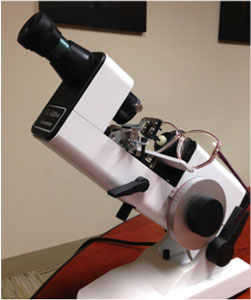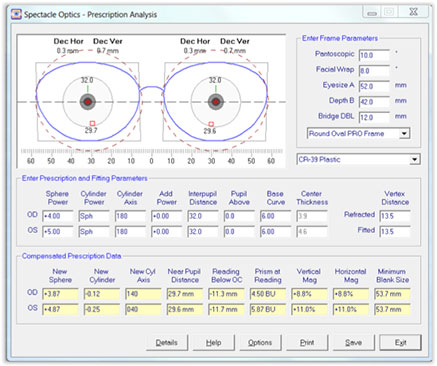It was suggested recently that I discuss the topic of “compensated lens powers.” With the growth of freeform technology pioneered by Zeiss, this issue has received increased attention. I have come to realize there is confusion over the fundamentals of compensated Rx’s. I will attempt to explain this in simple terms and avoid mathematical explanations.
To understand the issue, it is first important to realize that when any ophthalmic lens is positioned in front of the eye, the power that is delivered to the eye will vary for that specific lens depending upon how it is positioned in front of the eye. This change in observed power is dependent upon how the lens is tilted (faceform / pantoscopic tilt) and the vertex distance (distance from back of surface of the lens to the front of the eye). In other words, if a +4.00 diopter sphere lens measures exactly 4.00 Diopters when examined on a focimeter (lens meter), it will only be +4.00 as seen by the eye if it is not tilted and the vertex distance does not depart from average (10-12mm).

In an earlier article, I discussed what was new in ANSI Z80.1 – 2015. One important area of revision pertained to handling Rx’s which have been compensated (power adjusted) and how to handle this should the lens measure differently from the prescribed power. In ANSI, it is stated that if the power has been compensated, the verification power may not agree with the written Rx. It is the compensated power that should be used when applying tolerances from the measurement.
With the popularity of freeform technology, adjusting for power changes that result from frame fit have become commonplace. Compensated powers have become “easy” to implement given this technology. However, providing compensations to prescriptions is not entirely new. In the days of cataract lenses where strong plus powers were needed, vertex compensation to the power of the finished lens was an important factor in providing satisfactory lens performance. For example, if a +10 D lens was prescribed, a lens of a power other than +10 was made so that when positioned at a given vertex distance it would be seen as a +10. This is the same concept for today’s compensations.
Let’s look at an example. Shown at the right is an example from Darryl Meister’s spectacle optics utility program. I chose a +4.00 (OD) and +5.00 (OS) for the prescribed power but also adjusted to the frame fit to have 10 degrees of pantoscopic tilt and 8 degrees face wrap. The output in yellow shows that to deliver the exact +4.00 and +5.00 powers to the wearer, the lens should be made to adjusted powers. The +4.00 sphere lens should be surfaced to +3.87 sphere, -0.12 cyl and the +5.00 sphere should be made to +4.87 sphere, -0.25 cyl.

One might ask if the lens positioning of a lens changes the delivered power to the wearer, what has been happening for all lenses that have been put in similar frames and have not been compensated? The answer is for these traditionally made lenses, the wearer has not been seeing the exact power as prescribed, but there is some latitude of acceptance by the wearer for most of these differences.
Feel free to contact me if you have any questions or input: [email protected]












